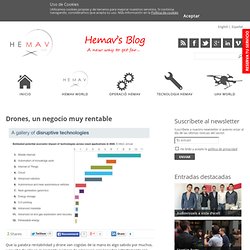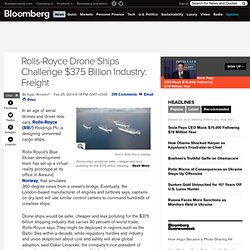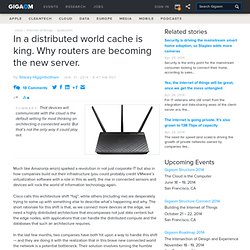

Drones, un negocio muy rentable » Hemav. Que la palabra rentabilidad y drone van cogidas de la mano es algo sabido por muchos, y prueba de ello es el creciente número de empresas relacionadas estrictamente con este sector.

Rentabilidad en 2 variantes, en cuanto a su aplicación para substituir a los medios tradicionales de trabajo, como también en lo económico; abaratamiento de costes, tiempo y mano de obra. A lo largo de estos años, la aplicación para el uso civil de la tecnología UAV, ha echo de esta una herramienta muy rentable e indispensable en muchos sectores industriales, tecnológicos y sociales.
A medida que la legislación española sobre el uso civil de drones va avanzando, otros países ya empiezan a ver los frutos verdes del uso de esta avanzada tecnología. Es el caso de Japón, donde actualmente el 40% de sus campos reciben el pesticida y fertilizantes mediante esta tecnología desde hace ya 20 años, o el de Corea del Sur y Uruguay, quiénes ya han substituido los helicópteros por drones para el cultivo de trigo y soja.
Controlar y destruir. «Al buscar el ojo de Dios, sólo he visto una órbita Vasta, negra y sin fondo, en la que la noche que la habita Resplandece en el mundo y siempre se ensancha.»

Gérard de Nerval El ojo de dios abarca con su mirada la totalidad del mundo. Internet of things: the influence of M2M data on the energy industry. Rolls-Royce’s Drone Shipbots Will Rule Tomorrow’s Oceans, Shipping Containers. Rolls-Royce Drone Ships Challenge $375 Billion Industry: Freight. In an age of aerial drones and driver-less cars, Rolls-Royce (RR/) Holdings Plc is designing unmanned cargo ships.

Rolls-Royce’s Blue Ocean development team has set up a virtual-reality prototype at its office in Alesund, Norway, that simulates 360-degree views from a vessel’s bridge. Eventually, the London-based manufacturer of engines and turbines says, captains on dry land will use similar control centers to command hundreds of crewless ships. Drone ships would be safer, cheaper and less polluting for the $375 billion shipping industry that carries 90 percent of world trade, Rolls-Royce says.
They might be deployed in regions such as the Baltic Sea within a decade, while regulatory hurdles and industry and union skepticism about cost and safety will slow global adoption, said Oskar Levander, the company’s vice president of innovation in marine engineering and technology. Related: The Next Revolutions: Drones Vs. Phones. It’s been a hell of a week worldwide.

Caracas, Venezuela: “What had been a slow-motion unravelling that had stretched out over many years went kinetic all of a sudden.” Kiev, Ukraine: “Dozens dead as protesters regain territory from police.” Bangkok, Thailand: “Four people have been killed and more than 60 injured after a gun battle erupted between police and anti-government protesters.” Sarajevo, Bosnia: “Thousands of protesters took to the streets, setting fire to the presidency building and hurling rocks and stones at police.”
Driverless Trucks Will Keep Army Safe From IEDs. Photo: Lockheed Martin U.S.

Army convoys will soon be able to roll into even the roughest of unfriendly foreign urban areas and combat zones without the worry of loss of life, thanks to new technology that will make large vehicles fully autonomous. In demonstrations earlier this month at Fort Hood, Texas, the U.S. Army Tank-Automotive Research, Development and Engineering Center (TARDEC) and Lockheed Martin demonstrated the ability of the Autonomous Mobility Appliqué System (AMAS), which gives full autonomy to convoys to operate in urban environments. In a distributed world cache is king. Why routers are becoming the new server. Much like Amazon(a amzn) sparked a revolution in not just corporate IT but also in how companies build out their infrastructure (you could probably credit VMware’s virtualization software with a role in this as well), the rise in connected sensors and devices will rock the world of information technology again.

Cisco calls this architecture shift “fog”, while others (including me) are desperately trying to some up with something else to describe what’s happening and why. The short rationale for this shift is that, as we connect more devices at the edge, we need a highly distributed architecture that encompasses not just data centers but the edge nodes, with applications that can handle the distributed compute and the databases that such an architecture requires. In the last few months, two companies have both hit upon a way to handle this shift — and they are doing it with the realization that in this brave new connected world the network is a potential bottleneck. Cisco isn’t alone.
Los drones y la guerra a distancia. En los últimos años los drones han cambiado la naturaleza de la guerra.

Pero no sólo se han convertido en una tecnología controvertida en el debate de la videovigilancia o de la política internacional, sino que también están dando lugar a una abundante bibliografía académica en ámbitos como la ética y la filosofía, al tiempo que se desarrolla su uso comercial y, con él, el artístico. Nos acercamos a ese debate poliédrico, en el centro nervioso de nuestra época I.- NEOGUERRASLa lógica del dron es la lógica de la ballesta. Out of Sight, Out of Mind: A visualization of drone strikes in Pakistan since 2004. Google Is Making A Land Grab For The Internet Of Things. Orihuela: “IoT tears down the walls between virtual and physical world” (II) In this second part of our interview to José Luis Orihuela, the author of Mundo Twitter (Twitter World) and 80 claves sobre el futuro del periodismo (80 keys about the future of journalism), elaborates on how m2m technology will impact the media and society itself.

This group just created a address book for the internet of things. The internet of things is coming, but few normal people want to be the intermediary between dozens or the hundreds of connected devices they will encounter each day.

So devices must talk to each other but how that will play out is up in the air. Startups and big vendors all have their ideas, and Tuesday night, a new startup made its pitch. The Wireless Registry has built a service that lets people register a unique name for their connected devices. The startup explains that it is like a DNS for the internet of things, but what it really sounds like is a way to associate your identity, needs and desires with your devices without going out to the internet. Impala: Another Google Inspired Platform Enters The Mainstream Data World. Amazon Web Services has added support for Impala, the Google inspired query tool developed by big data startup Cloudera.

It provides real-time, parallel processing for large amounts of data. With Impala, a developer can load new or access existing data to run their queries using an SQL-like language on AWS Elastic MapReduce clusters. Its faster, more accessible and shows the increasing use of SQL in Hadoop, the open-source system for distributed computing. Google Buys Boston Dynamics, Creator Of Big Dog. Google announced that they’ve acquired Boston Dynamics, creators of quad- and bi-pedal robots like Big Dog and PETMAN.
This is Google’s eighth robotics acquisition. The company did not disclose the details of the sale. The announcement appeared in the New York Times where Boston Dynamics CEO Marc Raibert said they would honor their DARPA military contracts although Google will not officially be a military contractor. The company, founded in 1992, has been working on standalone, gas-powered robots for the past decade. The robots are self-righting and very resilient. Why Does Google Need So Many Robots? To Jump From The Web To The Real World. Why does Google need robots? Because it already rules your pocket.
The mobile market, except for the slow rise of wearables, is saturated. There are millions of handsets around the world, each one connected to the Internet and most are running either Android or iOS. Except for incremental updates to the form, there will be few innovations coming out of the mobile space in the next decade. Why Does Google Need So Many Robots? To Jump From The Web To The Real World.